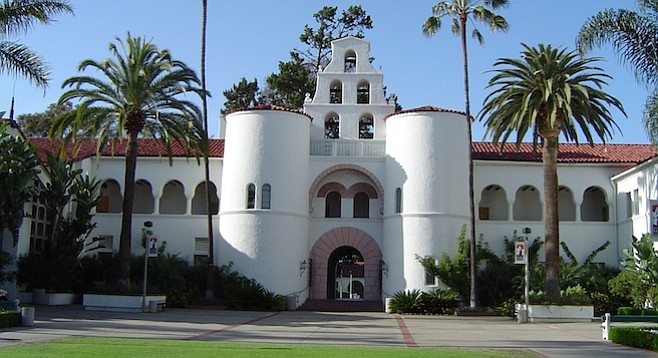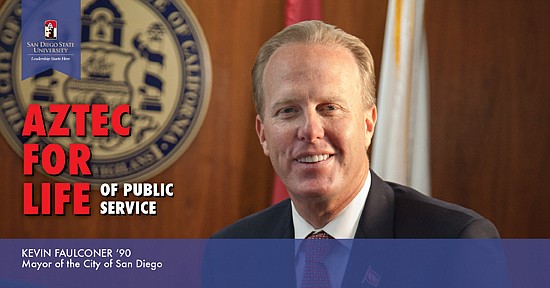 Facebook
Facebook
 X
X
 Instagram
Instagram
 TikTok
TikTok
 Youtube
Youtube

How sticky can a legal battle over an environmental impact report get?
Plenty, based on an August 3 ruling by the state supreme court against San Diego State University that may be regarded as a warning to Republican mayor Kevin Faulconer.
As controversy shadows Faulconer's hurry-up environmental impact report for a new stadium in Mission Valley, it's back to the drawing board for San Diego State University and its decade-long battle with the city over the school's mammoth campus expansion plans.
In a unanimous August 3 ruling, the state supreme court has held that SDSU and its parent, the California State University system, broke the law when officials certified an environmental impact report saying they couldn’t find millions of dollars needed to deal with increased traffic congestion and other negative effects of the giant development.
According to the decision, the school's expansion was designed to accommodate a projected boost in SDSU enrollment from 33,441 to 44,826, and the addition of 1,282 faculty and staff members.
SDSU's environmental impact report "acknowledged the proposed project would contribute significantly to cumulative traffic congestion off-campus in San Diego," yet argued that the eight figures or more in extra costs would have to be shouldered by "others."
State university board of trustees "identified the specific improvements that would mitigate most of the impacts to below a level of significance. The Board offered no assurance, however, that it would pay SDSU’s fair share of the mitigation costs."
University officials "predicted the project, in the near term, would significantly impact six intersections, three street segments and one freeway ramp meter, and in the longer term (by 2030), nine more intersections, five more street segments, and four freeway mainline segments."
The city joined with the San Diego Association of Governments, Caltrans, and the Metropolitan Transit System in December 2007 to sue over the report's omissions.
In response, the university "argued that to reallocate funds for off-site mitigation could only result in the underfunding of CSU’s core educational function."
The trustees also maintained that they had failed in attempts to obtain so-called mitigation money from the legislature, and didn't have the authority to use other funds.
"The Board contends the Legislature‘s failure to grant its request for an earmarked appropriation to mitigate off-site environmental effects has the effect of prohibiting CSU from spending any other public funds for that purpose, even funds generally appropriated for campus expansion," the decision notes.
But the court held otherwise, saying, "we reject the Board’s assumption that the feasibility of mitigating its project’s off-site environmental effects depends on a legislative appropriation for that specific purpose."
The opinion added, "We expect the Board, in any new EIR, will proceed in accordance with [state law], including its provisions for public comment, and make all required findings in good faith and on the basis of substantial evidence."

Not without some irony, GOP city attorney Jan Goldsmith, an ally in Faulconer's rush to issue a hurry-up stadium EIR, took a victory lap in the SDSU battle.
"This is an important decision which treats the CSU system like any other developer,” Goldsmith said in a statement to the Union-Tribune. “It must ... negotiate its fair share in a way that protects the environment and protects the city’s taxpayers.”


How sticky can a legal battle over an environmental impact report get?
Plenty, based on an August 3 ruling by the state supreme court against San Diego State University that may be regarded as a warning to Republican mayor Kevin Faulconer.
As controversy shadows Faulconer's hurry-up environmental impact report for a new stadium in Mission Valley, it's back to the drawing board for San Diego State University and its decade-long battle with the city over the school's mammoth campus expansion plans.
In a unanimous August 3 ruling, the state supreme court has held that SDSU and its parent, the California State University system, broke the law when officials certified an environmental impact report saying they couldn’t find millions of dollars needed to deal with increased traffic congestion and other negative effects of the giant development.
According to the decision, the school's expansion was designed to accommodate a projected boost in SDSU enrollment from 33,441 to 44,826, and the addition of 1,282 faculty and staff members.
SDSU's environmental impact report "acknowledged the proposed project would contribute significantly to cumulative traffic congestion off-campus in San Diego," yet argued that the eight figures or more in extra costs would have to be shouldered by "others."
State university board of trustees "identified the specific improvements that would mitigate most of the impacts to below a level of significance. The Board offered no assurance, however, that it would pay SDSU’s fair share of the mitigation costs."
University officials "predicted the project, in the near term, would significantly impact six intersections, three street segments and one freeway ramp meter, and in the longer term (by 2030), nine more intersections, five more street segments, and four freeway mainline segments."
The city joined with the San Diego Association of Governments, Caltrans, and the Metropolitan Transit System in December 2007 to sue over the report's omissions.
In response, the university "argued that to reallocate funds for off-site mitigation could only result in the underfunding of CSU’s core educational function."
The trustees also maintained that they had failed in attempts to obtain so-called mitigation money from the legislature, and didn't have the authority to use other funds.
"The Board contends the Legislature‘s failure to grant its request for an earmarked appropriation to mitigate off-site environmental effects has the effect of prohibiting CSU from spending any other public funds for that purpose, even funds generally appropriated for campus expansion," the decision notes.
But the court held otherwise, saying, "we reject the Board’s assumption that the feasibility of mitigating its project’s off-site environmental effects depends on a legislative appropriation for that specific purpose."
The opinion added, "We expect the Board, in any new EIR, will proceed in accordance with [state law], including its provisions for public comment, and make all required findings in good faith and on the basis of substantial evidence."

Not without some irony, GOP city attorney Jan Goldsmith, an ally in Faulconer's rush to issue a hurry-up stadium EIR, took a victory lap in the SDSU battle.
"This is an important decision which treats the CSU system like any other developer,” Goldsmith said in a statement to the Union-Tribune. “It must ... negotiate its fair share in a way that protects the environment and protects the city’s taxpayers.”
Comments